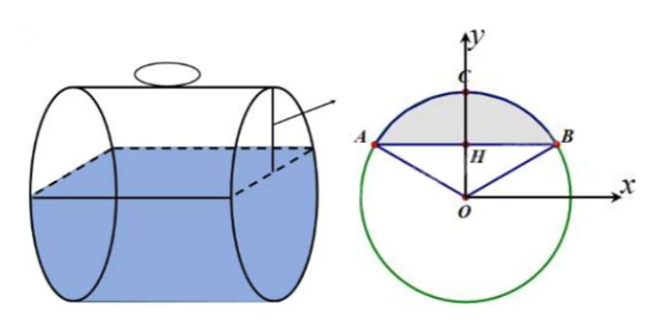Tất cả
Hỏi bài tập Toán Học
Vật Lý
Hóa Học
Tiếng Anh
Ngữ Văn
Hỏi đời sống Tâm lý cảm xúc
Tình cảm
Gia đình bạn bè
Cơ thể & Dậy thì
Giải trí
Mạng xã hội
Định hướng cuộc sống
Hỏi đáp ẩn danh
Câu 4: Một bể chứa nhiên liệu hình trụ đặt nằm ngang, có chiều dài 5 m, có bán kính đáy 1m. Chiều cao của mực nhiên liệu là 1,5m. Tính thể tích phần nhiên liệu trong bể (theo đơn vị m', làm tròn đến ch...
 0
0
-
Câu trả lời phải chính xác, đầy đủ dựa trên kiến thức xác thực:
- ✔ Đối với câu hỏi trắc nghiệm: Đưa đáp án lựa chọn + giải thích lý do chọn đáp án.
- ✔ Đối với câu hỏi tự luận: Đưa lời giải và đáp án cho câu hỏi.
- ✔ Đối với câu hỏi trả lời ngắn: Đưa ra đáp án + giải thích lý do.
- ✔ Chấp nhận sử dụng ảnh do thành viên viết tay, ảnh cần rõ nét, không bị mờ, vỡ ảnh.
- Sử dụng ngôn ngữ rõ ràng, dễ hiểu.
- Tránh đưa ra các ý kiến cá nhân mang tính chất chủ quan.
- Nếu sử dụng thông tin từ nguồn khác, phải trích dẫn nguồn đầy đủ và chính xác.
- Tuyệt đối không được sao chép các thông tin từ các trang khác, từ AI hoặc chatGPT.



26/02/2025
 0
0
26/02/2025
Thể tích của cả bể nhiên liệu là: $\displaystyle V=\pi r^{2} .h=\pi .1^{2} .5=5\pi \left( m^{3}\right)$
Gọi $\displaystyle V_{1}$ là thể tích phần trống nhiên liệu, $\displaystyle V_{2}$ là phần thể tích chứa nhiên liệu.
Khi đó, $\displaystyle V_{2} =V-V_{1}$. Để tìm $\displaystyle V_{2}$ theo yêu cầu đề bài, ta tính $\displaystyle V_{1}$ trước.
$\displaystyle V_{1} =B_{trong} .h$ với $\displaystyle B_{trong}$ là phần diện tích đáy không chứa nhiên liệu.
Chọn hệ trục Oxy như hình vẽ:

$\displaystyle B_{trong} =S_{ACB} =2S_{BHC}$
chiều cao mực nhiên liệu là 1,5m, bán kính đáy bằng 1m nên OH=0,5m
Ta có: $\displaystyle HB=\sqrt{OB^{2} -OH^{2}} =\sqrt{1^{2} -0,5^{2}} =\frac{\sqrt{3}}{2}$
Vậy $\displaystyle B\left(\frac{\sqrt{3}}{2} ;\frac{1}{2}\right)$
Đường tròn đáy là đường tròn tâm O, bán kính R=1 nên có phương trình $\displaystyle x^{2} +y^{2} =1$. Khi đó phần đồ thị nửa đường trong nằm trên trục hoành có phương trình $\displaystyle y=\sqrt{1-x^{2}}$
$\displaystyle S_{BHC}$ là phần diện tích giới hạn bởi nửa đường tròn $\displaystyle y=\sqrt{1-x^{2}}$, đường thẳng $\displaystyle y=\frac{1}{2}$, trục tung $\displaystyle x=0$ và điểm B có hoành độ $\displaystyle x=\frac{\sqrt{3}}{2}$
Ứng dụng tích phân để tính $\displaystyle S_{BHC}$, ta có:
$\displaystyle S_{BHC} =\int _{0}^{\frac{\sqrt{3}}{2}} |\sqrt{1-x^{2}} -\frac{1}{2} |dx=\int _{0}^{\frac{\sqrt{3}}{2}}\left(\sqrt{1-x^{2}} -\frac{1}{2}\right) dx\ $(do trong khoảng $\displaystyle \left( 0;\frac{\sqrt{3}}{2}\right)$ đồ thị $\displaystyle y=\sqrt{1-x^{2}}$ nằm phía trên đồ thị $\displaystyle y=\frac{1}{2}$, suy ra$\displaystyle \sqrt{1-x^{2}} >\frac{1}{2} \Longrightarrow \sqrt{1-x^{2}} -\frac{1}{2} >0\Longrightarrow |\sqrt{1-x^{2}} -\frac{1}{2} |=\sqrt{1-x^{2}} -\frac{1}{2})$
$\displaystyle S_{BHC} =\int _{0}^{\frac{\sqrt{3}}{2}}\left(\sqrt{1-x^{2}} -\frac{1}{2}\right) dx=\int _{0}^{\frac{\sqrt{3}}{2}}\left(\sqrt{1-x^{2}}\right) dx-\frac{1}{2}\int _{0}^{\frac{\sqrt{3}}{2}} dx$
Ta có:
$\displaystyle \frac{1}{2}\int _{0}^{\frac{\sqrt{3}}{2}} dx=\frac{1}{2} .\left(\frac{\sqrt{3}}{2} -0\right) =\frac{\sqrt{3}}{4}$
Để tính $\displaystyle \int _{0}^{\frac{\sqrt{3}}{2}}\left(\sqrt{1-x^{2}}\right) dx$, ta đặt $\displaystyle x=\sin t\Longrightarrow dx=\cos tdt$
Đổi cận

Khi đó $\displaystyle \int _{0}^{\frac{\sqrt{3}}{2}}\left(\sqrt{1-x^{2}}\right) dx=\int _{0}^{\frac{\pi }{3}}\left(\sqrt{1-\sin^{2} t}\right)\cos tdt=\int _{0}^{\frac{\pi }{3}} |\cos t|\cos tdt=\int _{0}^{\frac{\pi }{3}}\cos^{2} tdt$ (vì trong khoảng $\displaystyle \left( 0;\frac{\pi }{3}\right)$ $\displaystyle \cos t >0\Longrightarrow |\cos t|=\cos t)$
$\displaystyle \begin{array}{{>{\displaystyle}l}}
\Longrightarrow \int _{0}^{\frac{\sqrt{3}}{2}}(\sqrt{1-x^{2}} dx=\int _{0}^{\frac{\pi }{3}}\cos^{2} tdt=\int _{0}^{\frac{\pi }{3}}\frac{1+\cos 2x}{2} tdt=\int _{0}^{\frac{\pi }{3}}\left(\frac{1}{2} +\frac{\cos 2x}{2}\right) tdt\\
=\left(\frac{x}{2} +\frac{\sin 2x}{4}\right) |_{0}^{\frac{\pi }{3}} =\frac{\pi }{6} +\frac{\sin\frac{\pi }{3}}{4} =\frac{\pi }{6} +\frac{\sqrt{3}}{8}
\end{array}$
$\displaystyle S_{BHC} =\int _{0}^{\frac{\sqrt{3}}{2}}\left(\sqrt{1-x^{2}}\right) dx-\frac{1}{2}\int _{0}^{\frac{\sqrt{3}}{2}} dx=\frac{\pi }{6} +\frac{\sqrt{3}}{8} -\frac{\sqrt{3}}{4} =\frac{\pi }{6} -\frac{\sqrt{3}}{8}$
$\displaystyle \begin{array}{{>{\displaystyle}l}}
B_{trong} =2S_{BHC} =2.\left(\frac{\pi }{6} -\frac{\sqrt{3}}{8}\right) =\frac{\pi }{3} -\frac{\sqrt{3}}{4}\\
V_{1} =B_{trong} .h=5.\left(\frac{\pi }{3} -\frac{\sqrt{3}}{4}\right)
\end{array}$
Thể tích phần nhiên liệu trong bể là:
$\displaystyle V_{2} =V-V_{1} =5\pi -5.\left(\frac{\pi }{3} -\frac{\sqrt{3}}{4}\right) \approx 12,6\ \left( m^{3}\right)$
 0
0
Nếu bạn muốn hỏi bài tập
Các câu hỏi của bạn luôn được giải đáp dưới 10 phút
CÂU HỎI LIÊN QUAN
9 giờ trước
24/10/2025
Top thành viên trả lời



